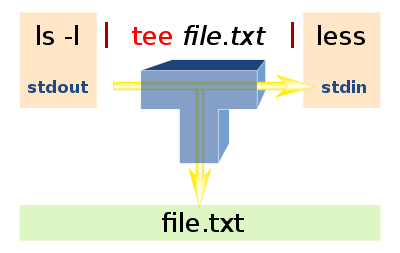
AWK is a domain-specific language designed for text processing and typically used as a data extraction and reporting tool. Like sed and grep, it is a filter, and is a standard feature of most Unix-like operating systems.
In computing, tar is a computer software utility for collecting many files into one archive file, often referred to as a tarball, for distribution or backup purposes. The name is derived from "tape archive", as it was originally developed to write data to sequential I/O devices with no file system of their own. The archive data sets created by tar contain various file system parameters, such as name, timestamps, ownership, file-access permissions, and directory organization. POSIX abandoned tar in favor of pax, yet tar sees continued widespread use.
In computer programming, standard streams are interconnected input and output communication channels between a computer program and its environment when it begins execution. The three input/output (I/O) connections are called standard input (stdin), standard output (stdout) and standard error (stderr). Originally I/O happened via a physically connected system console, but standard streams abstract this. When a command is executed via an interactive shell, the streams are typically connected to the text terminal on which the shell is running, but can be changed with redirection or a pipeline. More generally, a child process inherits the standard streams of its parent process.
dd is a command-line utility for Unix, Plan 9, Inferno, and Unix-like operating systems and beyond, the primary purpose of which is to convert and copy files. On Unix, device drivers for hardware and special device files appear in the file system just like normal files; dd can also read and/or write from/to these files, provided that function is implemented in their respective driver. As a result, dd can be used for tasks such as backing up the boot sector of a hard drive, and obtaining a fixed amount of random data. The dd program can also perform conversions on the data as it is copied, including byte order swapping and conversion to and from the ASCII and EBCDIC text encodings.

In computing, redirection is a form of interprocess communication, and is a function common to most command-line interpreters, including the various Unix shells that can redirect standard streams to user-specified locations.

wc is a command in Unix, Plan 9, Inferno, and Unix-like operating systems. The program reads either standard input or a list of computer files and generates one or more of the following statistics: newline count, word count, and byte count. If a list of files is provided, both individual file and total statistics follow.

cksum is a command in Unix and Unix-like operating systems that generates a checksum value for a file or stream of data. The cksum command reads each file given in its arguments, or standard input if no arguments are provided, and outputs the file's 32-bit cyclic redundancy check (CRC) checksum and byte count. The CRC output by cksum is different from the CRC-32 used in zip, PNG and zlib.
split is a utility on Unix, Plan 9, and Unix-like operating systems most commonly used to split a computer file into two or more smaller files.
paste is a Unix command line utility which is used to join files horizontally by outputting lines consisting of the sequentially corresponding lines of each file specified, separated by tabs, to the standard output.

In Unix-like computer operating systems, a pipeline is a mechanism for inter-process communication using message passing. A pipeline is a set of processes chained together by their standard streams, so that the output text of each process (stdout) is passed directly as input (stdin) to the next one. The second process is started as the first process is still executing, and they are executed concurrently. The concept of pipelines was championed by Douglas McIlroy at Unix's ancestral home of Bell Labs, during the development of Unix, shaping its toolbox philosophy. It is named by analogy to a physical pipeline. A key feature of these pipelines is their "hiding of internals". This in turn allows for more clarity and simplicity in the system.
In Unix-like and some other operating systems, find is a command-line utility that locates files based on some user-specified criteria and either prints the pathname of each matched object or, if another action is requested, performs that action on each matched object.

A command shell is a command-line interface to interact with and manipulate a computer's operating system.

In computing, more is a command to view the contents of a text file one screen at a time. It is available on Unix and Unix-like systems, DOS, Digital Research FlexOS, IBM/Toshiba 4690 OS, IBM OS/2, Microsoft Windows and ReactOS. Programs of this sort are called pagers. more is a very basic pager, originally allowing only forward navigation through a file, though newer implementations do allow for limited backward movement.
tail is a program available on Unix, Unix-like systems, FreeDOS and MSX-DOS used to display the tail end of a text file or piped data.

yes is a command on Unix and Unix-like operating systems, which outputs an affirmative response, or a user-defined string of text, continuously until killed.
A filter is a computer program or subroutine to process a stream, producing another stream. While a single filter can be used individually, they are frequently strung together to form a pipeline.

In computing, alias is a command in various command-line interpreters (shells), which enables a replacement of a word by another string. It is mainly used for abbreviating a system command, or for adding default arguments to a regularly used command. alias is available in Unix shells, AmigaDOS, 4DOS/4NT, KolibriOS, Windows PowerShell, ReactOS, and the EFI shell. Aliasing functionality in the MS-DOS and Microsoft Windows operating systems is provided by the DOSKey command-line utility.
pexec is a command-line utility for Linux and other Unix-like operating systems which allows the user to execute shell commands in parallel. The specified code can be executed either locally or on remote hosts, in which case ssh is used to build a secure tunnel between them. Similar to shell loops, a variable is changed as the loop starting the tasks iterates, so that many values can get passed to the specified command or script. pexec is a free software utility, and part of the GNU Project. It is available under the terms of GPLv3, and is part of the current Debian stable release.

A command-line interface (CLI) is a means of interacting with a computer program by inputting lines of text called command-lines. Command-line interfaces emerged in the mid-1960s, on computer terminals, as a user-friendly alternative to punched cards.

cat is a standard Unix utility that reads files sequentially, writing them to standard output. The name is derived from its function to (con)catenate files. It has been ported to a number of operating systems.











